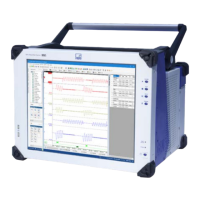GEN7iB
286
GEN series SYNCHRONIZATION METHODS
GEN series SYNCHRONIZATION METHODS
14
14.2.4 PTP switch types
WithinthePTPspecication,twotypesofswitchesaredened:
● Boundary clock switches
● Transparent clock switches
Boundary clock
BoundaryclocksaredenedwithinaPTPsystemtobeintegratedinplacewherestan-
dardnetworkswitchesorroutersareused.BoundaryclocksaredenedasPTPclocks
with more than a single PTP port, with each port providing access to a separate PTP
communication path. The boundary clock acts as an interface between separate PTP
domains intercepting and processing all PTP messages and passing all other network
trac.TheBMCalgorithmisusedbytheboundaryclocktoselectthebestclockany
port can see. The chosen port (the one that receives the best clock) is set as a slave
and all other ports of the boundary clock are asserted as masters to their domain (to
forward the clock).
Transparent clock
Transparent clocks have been added to Version 2 of the standard as an improved
method of forming cascaded topologies. Rather than acting as a multi-port ordinary
clock as boundary clocks do, transparent clocks update a newly introduced time-inter-
valeldwithinPTPeventmessages.This64bittime-intervalcorrectioneldallowsfor
switch delay compensation to a potential accuracy of less than a picosecond. There
are two types of transparent clocks, End-to-End and Peer-to-Peer. End-to-End transpar-
entclocksupdatethetimeintervaleldforthedelayassociatedwithindividualpacket
transfers, whereas Peer-to-Peer transparent clocks measure the line delay associated
withtheingresstransmissionpathandincludethisdelayinthecorrectioneldalso.
Peer-to-Peertransparentclockscanallowforfasterrecongurationafternetwork
topology changes.

